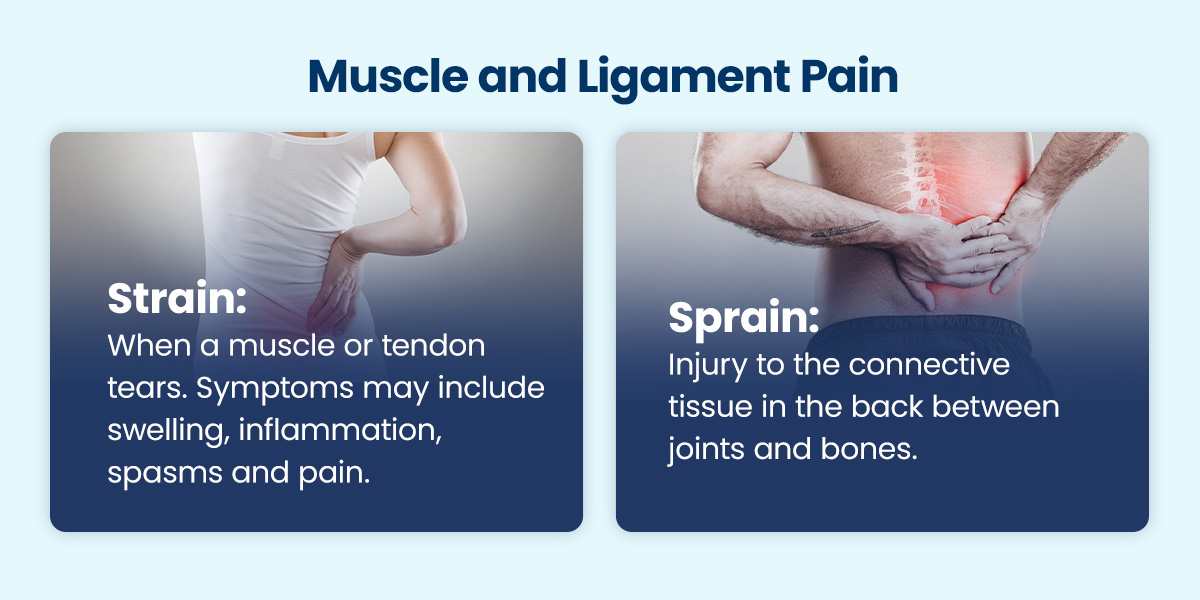The force of a collision can cause pain all over your body, making it challenging to identify the source. It’s common to sustain back injuries from a car accident. After a crash, you should get examined by a health care practitioner skilled in recognizing musculoskeletal injuries immediately. Assessing and treating your injuries can prevent long-term health problems.
In a high-speed crash or rear-end collision, your body experiences violent motion. You may hit the steering wheel or airbag or jerk forward and backward. The impact on your spine can result in upper and lower back injuries from the car accident.
The lumbar or lower back region is the most common area for back injuries. Five vertebrae make up the lumbar spine. Each vertebra has a gel-like cushion with a rigid outer ring between it. Symptoms of lower back pain include a sharp or dull ache that may radiate to other body parts like the legs.
Your thoracic spine is the middle 12 vertebrae that extends from the bottom ribs to the base of the neck. Trauma to this area is less common but can be more severe than lower back pain. Signs of thoracic spine injury range from radiating pain to breathing difficulty.
The cervical spine or neck area consists of seven vertebrae. Symptoms of neck trauma may include pain when moving your head or tingling in your arms and legs.
It can be challenging to pinpoint a back injury after an accident. You may be sore all over and a spinal injury can cause pain to travel to other areas of the body. Here are some signs that indicate back trauma:
The trauma from a vehicle collision causes a range of injuries in the upper and lower back.
Your head jerking forward and backward impacts the cervical spine nerves. Since they act as shock absorbers, the cervical vertebra takes the brunt of force during a crash. Symptoms such as pain, stiffness and loss of mobility in the neck can indicate whiplash.
If left untreated, whiplash may cause a concussion, restricted neck mobility and long-term pain.
Severe trauma can cause the vertebrae to fracture or break. The three more common fractures include:
Spinal discs are fluid-filled cushions that sit between your vertebrae. They absorb the impact of movement, such as walking or running. If discs shift during a car accident, part of the disc can push through a weaker area. A bulging or herniated disc puts pressure on the nerves. You may experience tingling, numbness or chronic pain.
The facet joints connect your vertebrae, supporting neck movement. Facet joints are a common reason for back pain affecting the lumbar spine. You may experience a dull ache in the lower back that spreads to the buttocks or thighs. Previous trauma or thinner cartilage increases the risk of this back injury.

After an accident, you may experience strains or sprains in the soft tissues of your back and neck:
Soft tissue damage doesn’t show up on imaging. You will need to consult a health care professional for an accurate diagnosis.
Trauma to the skull and brain can lead to migraine headaches. Migraines may manifest as light sensitivity, nausea, dizziness and confusion.
Spondylolisthesis happens when a vertebral disc slips out of place. The displaced disc puts pressure on the vertebrae below. Symptoms include back pain that worsens when standing or sitting and radiating numbness.
Diagnosing back pain from a car accident involves the following steps:
The treatment method depends on the type of injury, its location and pain severity. Treatment may include:
When should you see a doctor if you have back pain after a car accident? Immediately. If you have a sore back after a car accident, seek medical treatment before it worsens. Left untreated, you may experience:
A crash is a high-stress situation. Your body releases adrenaline, which may mask pain symptoms. Delayed lower back pain after a car accident may present hours, days or months later. Getting examined as soon as possible reduces the risk of long-term health consequences.
How long you continue to experience back pain after a car accident depends on factors like the injury severity, location and your overall health. Pain from minor injuries could resolve in a few days or weeks, but serious trauma could result in months or years of chronic back pain. Getting treated by a chiropractor or physiotherapist helps recovery and pain relief.
Back pain after an accident may indicate deeper injuries like soft tissue damage or spinal misalignment. At Complete Care, our Injury Care and Rehabilitation team provides personalized treatment to relieve pain, restore function, and prevent long-term issues.
The information provided on this website does not, and is not intended to, constitute legal advice; instead, all information, content, and materials available on this site are for general informational purposes only. Information on this website may not constitute the most up-to-date legal or other information. This website contains links to other third-party websites. Such links are only for the convenience of the reader, user or browser.